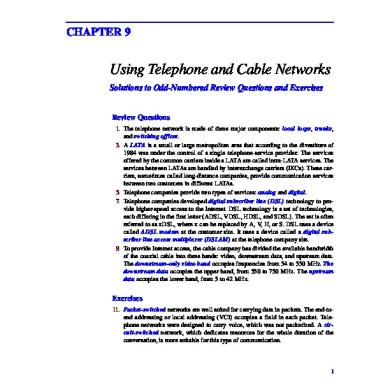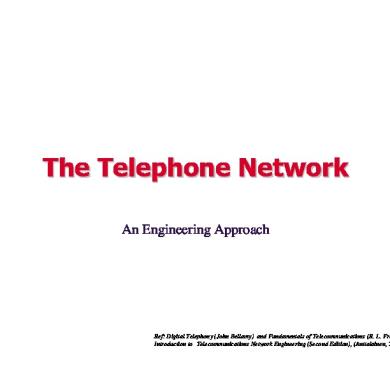Using Telephone And Cable Networks
This document was uploaded by user and they confirmed that they have the permission to share it. If you are author or own the copyright of this book, please report to us by using this DMCA report form. Report DMCA
Overview
Download & View Using Telephone And Cable Networks as PDF for free.
More details
- Words: 481
- Pages: 2
CHAPTER 9
Using Telephone and Cable Networks Solutions to Odd-Numbered Review Questions and Exercises Review Questions 1. The telephone network is made of three major components: local loops, trunks, and switching offices. 3. A LATA is a small or large metropolitan area that according to the divestiture of 1984 was under the control of a single telephone-service provider. The services offered by the common carriers inside a LATA are called intra-LATA services. The services between LATAs are handled by interexchange carriers (IXCs). These carriers, sometimes called long-distance companies, provide communication services between two customers in different LATAs. 5. Telephone companies provide two types of services: analog and digital. 7. Telephone companies developed digital subscriber line (DSL) technology to provide higher-speed access to the Internet. DSL technology is a set of technologies, each differing in the first letter (ADSL, VDSL, HDSL, and SDSL). The set is often referred to as xDSL, where x can be replaced by A, V, H, or S. DSL uses a device called ADSL modem at the customer site. It uses a device called a digital subscriber line access multiplexer (DSLAM) at the telephone company site. 9. To provide Internet access, the cable company has divided the available bandwidth of the coaxial cable into three bands: video, downstream data, and upstream data. The downstream-only video band occupies frequencies from 54 to 550 MHz. The downstream data occupies the upper band, from 550 to 750 MHz. The upstream data occupies the lower band, from 5 to 42 MHz.
Exercises 11. Packet-switched networks are well suited for carrying data in packets. The end-toend addressing or local addressing (VCI) occupies a field in each packet. Telephone networks were designed to carry voice, which was not packetized. A circuit-switched network, which dedicates resources for the whole duration of the conversation, is more suitable for this type of communication.
1
2
13. In a telephone network, the telephone numbers of the caller and callee are serving as source and destination addresses. These are used only during the setup (dialing) and teardown (hanging up) phases. 15. See Figure 9.1. Figure 9.1 Solution to Exercise 15 60 kbps 56 kbps 50 kbps 40 kbps 30 kbps 20 kbps 14.4 kbps 10 kbps
9600 bps V.32
V.32bis
V.90
17. a. V.32 b. V.32bis c. V.90
→ → →
Time = (1,000,000 × 8) /9600 Time = (1,000,000 × 8) / 14400 Time = (1,000,000 × 8) / 56000
≈ 834 s ≈ 556 s ≈ 143 s
19. We can calculate time based on the assumption of 10 Mbps data rate: Time = (1,000,000 × 8) / 10,000,000 ≈ 0.8 seconds 21. The cable modem technology is based on the bus (or rather tree) topology. The cable is distributed in the area and customers have to share the available bandwidth. This means if all neighbors try to transfer data, the effective data rate will be decreased.
Using Telephone and Cable Networks Solutions to Odd-Numbered Review Questions and Exercises Review Questions 1. The telephone network is made of three major components: local loops, trunks, and switching offices. 3. A LATA is a small or large metropolitan area that according to the divestiture of 1984 was under the control of a single telephone-service provider. The services offered by the common carriers inside a LATA are called intra-LATA services. The services between LATAs are handled by interexchange carriers (IXCs). These carriers, sometimes called long-distance companies, provide communication services between two customers in different LATAs. 5. Telephone companies provide two types of services: analog and digital. 7. Telephone companies developed digital subscriber line (DSL) technology to provide higher-speed access to the Internet. DSL technology is a set of technologies, each differing in the first letter (ADSL, VDSL, HDSL, and SDSL). The set is often referred to as xDSL, where x can be replaced by A, V, H, or S. DSL uses a device called ADSL modem at the customer site. It uses a device called a digital subscriber line access multiplexer (DSLAM) at the telephone company site. 9. To provide Internet access, the cable company has divided the available bandwidth of the coaxial cable into three bands: video, downstream data, and upstream data. The downstream-only video band occupies frequencies from 54 to 550 MHz. The downstream data occupies the upper band, from 550 to 750 MHz. The upstream data occupies the lower band, from 5 to 42 MHz.
Exercises 11. Packet-switched networks are well suited for carrying data in packets. The end-toend addressing or local addressing (VCI) occupies a field in each packet. Telephone networks were designed to carry voice, which was not packetized. A circuit-switched network, which dedicates resources for the whole duration of the conversation, is more suitable for this type of communication.
1
2
13. In a telephone network, the telephone numbers of the caller and callee are serving as source and destination addresses. These are used only during the setup (dialing) and teardown (hanging up) phases. 15. See Figure 9.1. Figure 9.1 Solution to Exercise 15 60 kbps 56 kbps 50 kbps 40 kbps 30 kbps 20 kbps 14.4 kbps 10 kbps
9600 bps V.32
V.32bis
V.90
17. a. V.32 b. V.32bis c. V.90
→ → →
Time = (1,000,000 × 8) /9600 Time = (1,000,000 × 8) / 14400 Time = (1,000,000 × 8) / 56000
≈ 834 s ≈ 556 s ≈ 143 s
19. We can calculate time based on the assumption of 10 Mbps data rate: Time = (1,000,000 × 8) / 10,000,000 ≈ 0.8 seconds 21. The cable modem technology is based on the bus (or rather tree) topology. The cable is distributed in the area and customers have to share the available bandwidth. This means if all neighbors try to transfer data, the effective data rate will be decreased.
Related Documents

Using Telephone And Cable Networks
June 2020 5
Telephone Networks
May 2020 5
Cellular Telephone Networks
May 2020 10
Telephone
June 2020 17
Rainfall Prediction Using Neural Networks
December 2019 13